Public Health Case Study: Improving Cervical Cancer Screening Access
VerifiedAdded on 2023/06/15
|8
|1799
|457
Case Study
AI Summary
This case study examines the global burden of cervical cancer, particularly in low-resource settings, and explores strategies to improve screening and prevention. It highlights the limitations of traditional Pap smear testing in these regions and advocates for alternative methods like HPV testing and visual inspection with acetic acid. The study assesses the cost-effectiveness and feasibility of different screening approaches, emphasizing the importance of sensitivity, specificity, and accessibility. It also discusses the challenges faced by initiatives aimed at improving cervical cancer screening, including partnership issues, the need for cost-effective tools, and skepticism towards alternatives to Pap smears. The evolution of cervical cancer prevention efforts in Africa is reviewed, highlighting the shift towards comprehensive approaches that consider accessibility, affordability, provider training, and healthcare infrastructure. The case study concludes by emphasizing the importance of developing national registries to track new cases and inform future prevention projects. Desklib offers a wealth of resources for students, including similar case studies, solved assignments, and past papers.

Running head: PUBLIC HEALTH
Public health
Name of the student:
Name of the University:
Author’s note
Public health
Name of the student:
Name of the University:
Author’s note
Paraphrase This Document
Need a fresh take? Get an instant paraphrase of this document with our AI Paraphraser
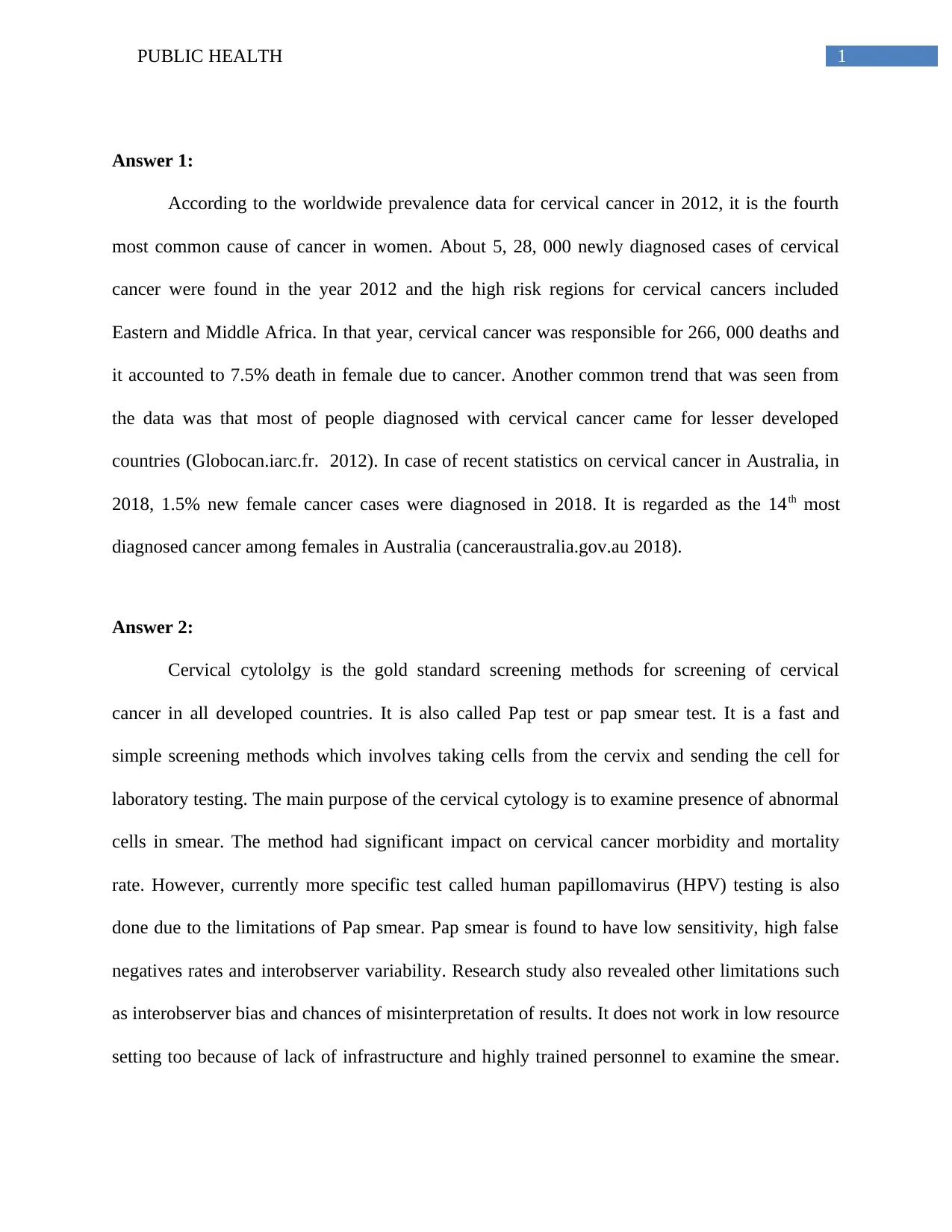
1PUBLIC HEALTH
Answer 1:
According to the worldwide prevalence data for cervical cancer in 2012, it is the fourth
most common cause of cancer in women. About 5, 28, 000 newly diagnosed cases of cervical
cancer were found in the year 2012 and the high risk regions for cervical cancers included
Eastern and Middle Africa. In that year, cervical cancer was responsible for 266, 000 deaths and
it accounted to 7.5% death in female due to cancer. Another common trend that was seen from
the data was that most of people diagnosed with cervical cancer came for lesser developed
countries (Globocan.iarc.fr. 2012). In case of recent statistics on cervical cancer in Australia, in
2018, 1.5% new female cancer cases were diagnosed in 2018. It is regarded as the 14th most
diagnosed cancer among females in Australia (canceraustralia.gov.au 2018).
Answer 2:
Cervical cytololgy is the gold standard screening methods for screening of cervical
cancer in all developed countries. It is also called Pap test or pap smear test. It is a fast and
simple screening methods which involves taking cells from the cervix and sending the cell for
laboratory testing. The main purpose of the cervical cytology is to examine presence of abnormal
cells in smear. The method had significant impact on cervical cancer morbidity and mortality
rate. However, currently more specific test called human papillomavirus (HPV) testing is also
done due to the limitations of Pap smear. Pap smear is found to have low sensitivity, high false
negatives rates and interobserver variability. Research study also revealed other limitations such
as interobserver bias and chances of misinterpretation of results. It does not work in low resource
setting too because of lack of infrastructure and highly trained personnel to examine the smear.
Answer 1:
According to the worldwide prevalence data for cervical cancer in 2012, it is the fourth
most common cause of cancer in women. About 5, 28, 000 newly diagnosed cases of cervical
cancer were found in the year 2012 and the high risk regions for cervical cancers included
Eastern and Middle Africa. In that year, cervical cancer was responsible for 266, 000 deaths and
it accounted to 7.5% death in female due to cancer. Another common trend that was seen from
the data was that most of people diagnosed with cervical cancer came for lesser developed
countries (Globocan.iarc.fr. 2012). In case of recent statistics on cervical cancer in Australia, in
2018, 1.5% new female cancer cases were diagnosed in 2018. It is regarded as the 14th most
diagnosed cancer among females in Australia (canceraustralia.gov.au 2018).
Answer 2:
Cervical cytololgy is the gold standard screening methods for screening of cervical
cancer in all developed countries. It is also called Pap test or pap smear test. It is a fast and
simple screening methods which involves taking cells from the cervix and sending the cell for
laboratory testing. The main purpose of the cervical cytology is to examine presence of abnormal
cells in smear. The method had significant impact on cervical cancer morbidity and mortality
rate. However, currently more specific test called human papillomavirus (HPV) testing is also
done due to the limitations of Pap smear. Pap smear is found to have low sensitivity, high false
negatives rates and interobserver variability. Research study also revealed other limitations such
as interobserver bias and chances of misinterpretation of results. It does not work in low resource
setting too because of lack of infrastructure and highly trained personnel to examine the smear.
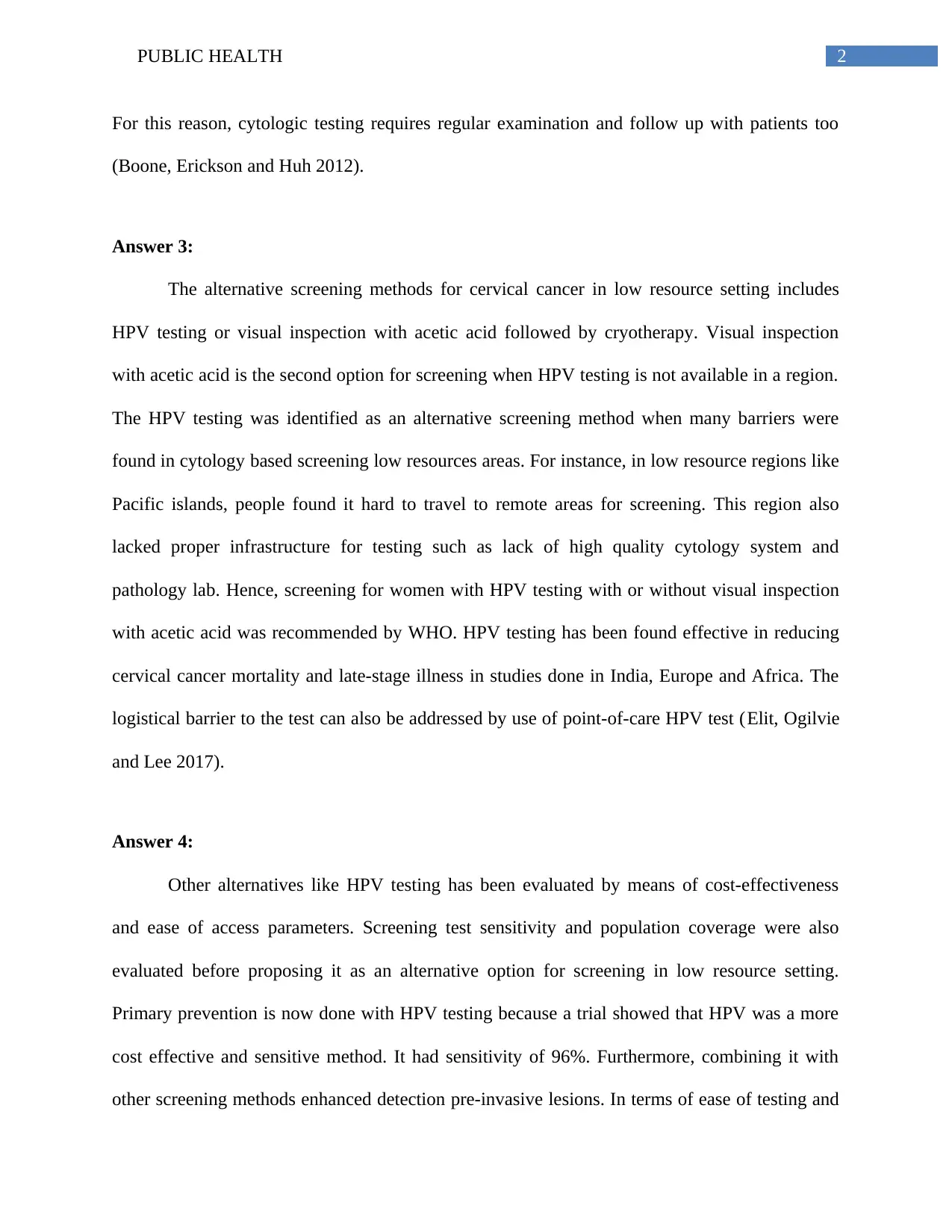
2PUBLIC HEALTH
For this reason, cytologic testing requires regular examination and follow up with patients too
(Boone, Erickson and Huh 2012).
Answer 3:
The alternative screening methods for cervical cancer in low resource setting includes
HPV testing or visual inspection with acetic acid followed by cryotherapy. Visual inspection
with acetic acid is the second option for screening when HPV testing is not available in a region.
The HPV testing was identified as an alternative screening method when many barriers were
found in cytology based screening low resources areas. For instance, in low resource regions like
Pacific islands, people found it hard to travel to remote areas for screening. This region also
lacked proper infrastructure for testing such as lack of high quality cytology system and
pathology lab. Hence, screening for women with HPV testing with or without visual inspection
with acetic acid was recommended by WHO. HPV testing has been found effective in reducing
cervical cancer mortality and late-stage illness in studies done in India, Europe and Africa. The
logistical barrier to the test can also be addressed by use of point-of-care HPV test (Elit, Ogilvie
and Lee 2017).
Answer 4:
Other alternatives like HPV testing has been evaluated by means of cost-effectiveness
and ease of access parameters. Screening test sensitivity and population coverage were also
evaluated before proposing it as an alternative option for screening in low resource setting.
Primary prevention is now done with HPV testing because a trial showed that HPV was a more
cost effective and sensitive method. It had sensitivity of 96%. Furthermore, combining it with
other screening methods enhanced detection pre-invasive lesions. In terms of ease of testing and
For this reason, cytologic testing requires regular examination and follow up with patients too
(Boone, Erickson and Huh 2012).
Answer 3:
The alternative screening methods for cervical cancer in low resource setting includes
HPV testing or visual inspection with acetic acid followed by cryotherapy. Visual inspection
with acetic acid is the second option for screening when HPV testing is not available in a region.
The HPV testing was identified as an alternative screening method when many barriers were
found in cytology based screening low resources areas. For instance, in low resource regions like
Pacific islands, people found it hard to travel to remote areas for screening. This region also
lacked proper infrastructure for testing such as lack of high quality cytology system and
pathology lab. Hence, screening for women with HPV testing with or without visual inspection
with acetic acid was recommended by WHO. HPV testing has been found effective in reducing
cervical cancer mortality and late-stage illness in studies done in India, Europe and Africa. The
logistical barrier to the test can also be addressed by use of point-of-care HPV test (Elit, Ogilvie
and Lee 2017).
Answer 4:
Other alternatives like HPV testing has been evaluated by means of cost-effectiveness
and ease of access parameters. Screening test sensitivity and population coverage were also
evaluated before proposing it as an alternative option for screening in low resource setting.
Primary prevention is now done with HPV testing because a trial showed that HPV was a more
cost effective and sensitive method. It had sensitivity of 96%. Furthermore, combining it with
other screening methods enhanced detection pre-invasive lesions. In terms of ease of testing and
⊘ This is a preview!⊘
Do you want full access?
Subscribe today to unlock all pages.

Trusted by 1+ million students worldwide
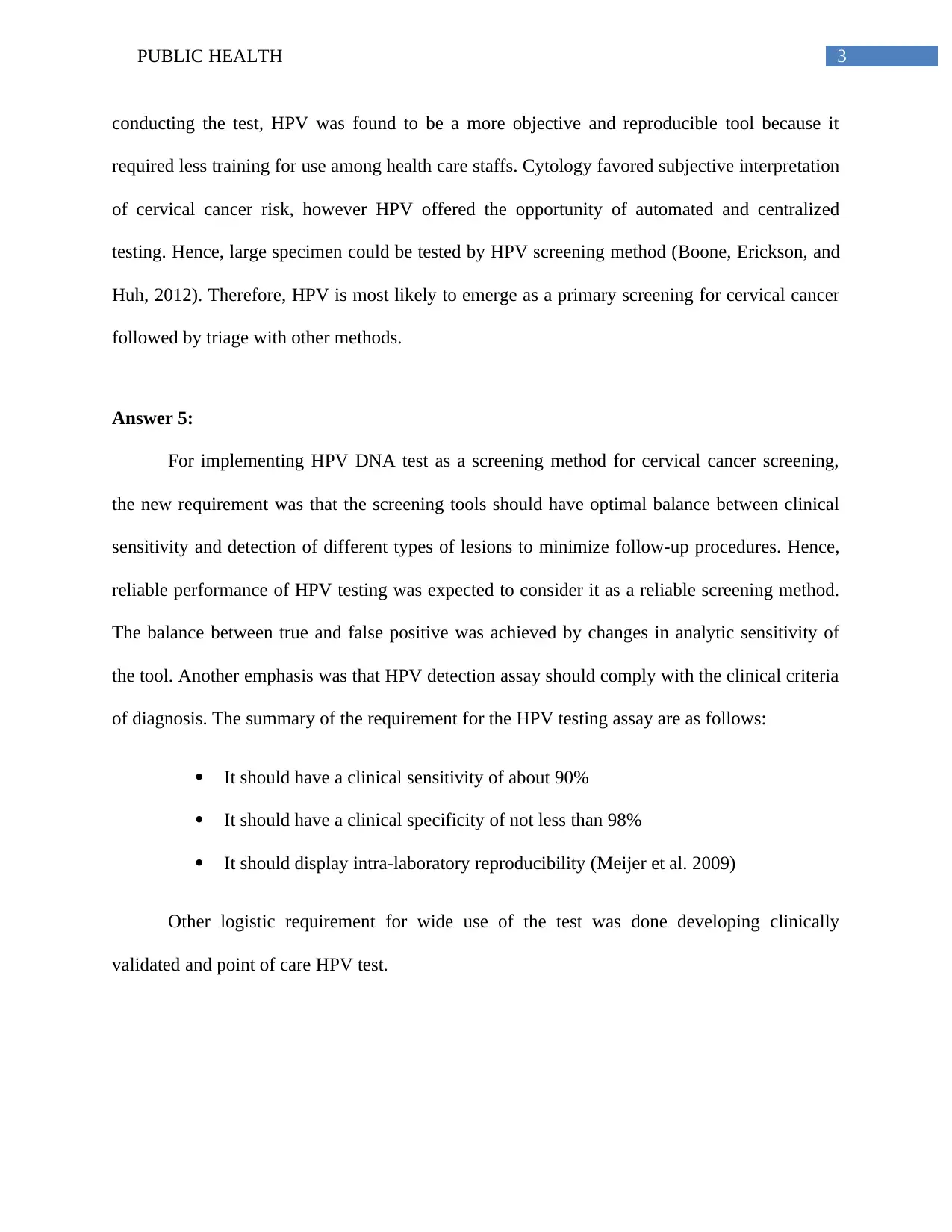
3PUBLIC HEALTH
conducting the test, HPV was found to be a more objective and reproducible tool because it
required less training for use among health care staffs. Cytology favored subjective interpretation
of cervical cancer risk, however HPV offered the opportunity of automated and centralized
testing. Hence, large specimen could be tested by HPV screening method (Boone, Erickson, and
Huh, 2012). Therefore, HPV is most likely to emerge as a primary screening for cervical cancer
followed by triage with other methods.
Answer 5:
For implementing HPV DNA test as a screening method for cervical cancer screening,
the new requirement was that the screening tools should have optimal balance between clinical
sensitivity and detection of different types of lesions to minimize follow-up procedures. Hence,
reliable performance of HPV testing was expected to consider it as a reliable screening method.
The balance between true and false positive was achieved by changes in analytic sensitivity of
the tool. Another emphasis was that HPV detection assay should comply with the clinical criteria
of diagnosis. The summary of the requirement for the HPV testing assay are as follows:
It should have a clinical sensitivity of about 90%
It should have a clinical specificity of not less than 98%
It should display intra-laboratory reproducibility (Meijer et al. 2009)
Other logistic requirement for wide use of the test was done developing clinically
validated and point of care HPV test.
conducting the test, HPV was found to be a more objective and reproducible tool because it
required less training for use among health care staffs. Cytology favored subjective interpretation
of cervical cancer risk, however HPV offered the opportunity of automated and centralized
testing. Hence, large specimen could be tested by HPV screening method (Boone, Erickson, and
Huh, 2012). Therefore, HPV is most likely to emerge as a primary screening for cervical cancer
followed by triage with other methods.
Answer 5:
For implementing HPV DNA test as a screening method for cervical cancer screening,
the new requirement was that the screening tools should have optimal balance between clinical
sensitivity and detection of different types of lesions to minimize follow-up procedures. Hence,
reliable performance of HPV testing was expected to consider it as a reliable screening method.
The balance between true and false positive was achieved by changes in analytic sensitivity of
the tool. Another emphasis was that HPV detection assay should comply with the clinical criteria
of diagnosis. The summary of the requirement for the HPV testing assay are as follows:
It should have a clinical sensitivity of about 90%
It should have a clinical specificity of not less than 98%
It should display intra-laboratory reproducibility (Meijer et al. 2009)
Other logistic requirement for wide use of the test was done developing clinically
validated and point of care HPV test.
Paraphrase This Document
Need a fresh take? Get an instant paraphrase of this document with our AI Paraphraser
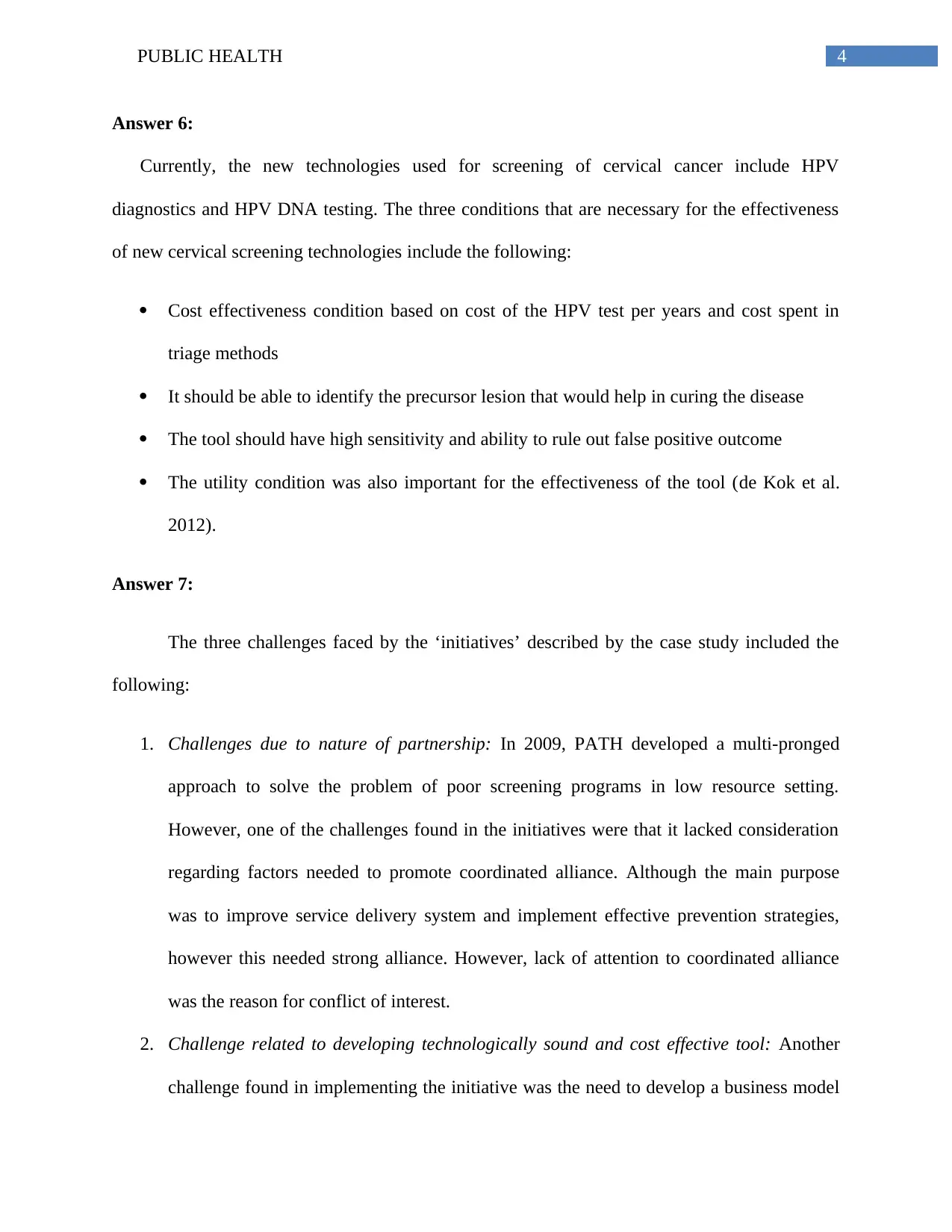
4PUBLIC HEALTH
Answer 6:
Currently, the new technologies used for screening of cervical cancer include HPV
diagnostics and HPV DNA testing. The three conditions that are necessary for the effectiveness
of new cervical screening technologies include the following:
Cost effectiveness condition based on cost of the HPV test per years and cost spent in
triage methods
It should be able to identify the precursor lesion that would help in curing the disease
The tool should have high sensitivity and ability to rule out false positive outcome
The utility condition was also important for the effectiveness of the tool (de Kok et al.
2012).
Answer 7:
The three challenges faced by the ‘initiatives’ described by the case study included the
following:
1. Challenges due to nature of partnership: In 2009, PATH developed a multi-pronged
approach to solve the problem of poor screening programs in low resource setting.
However, one of the challenges found in the initiatives were that it lacked consideration
regarding factors needed to promote coordinated alliance. Although the main purpose
was to improve service delivery system and implement effective prevention strategies,
however this needed strong alliance. However, lack of attention to coordinated alliance
was the reason for conflict of interest.
2. Challenge related to developing technologically sound and cost effective tool: Another
challenge found in implementing the initiative was the need to develop a business model
Answer 6:
Currently, the new technologies used for screening of cervical cancer include HPV
diagnostics and HPV DNA testing. The three conditions that are necessary for the effectiveness
of new cervical screening technologies include the following:
Cost effectiveness condition based on cost of the HPV test per years and cost spent in
triage methods
It should be able to identify the precursor lesion that would help in curing the disease
The tool should have high sensitivity and ability to rule out false positive outcome
The utility condition was also important for the effectiveness of the tool (de Kok et al.
2012).
Answer 7:
The three challenges faced by the ‘initiatives’ described by the case study included the
following:
1. Challenges due to nature of partnership: In 2009, PATH developed a multi-pronged
approach to solve the problem of poor screening programs in low resource setting.
However, one of the challenges found in the initiatives were that it lacked consideration
regarding factors needed to promote coordinated alliance. Although the main purpose
was to improve service delivery system and implement effective prevention strategies,
however this needed strong alliance. However, lack of attention to coordinated alliance
was the reason for conflict of interest.
2. Challenge related to developing technologically sound and cost effective tool: Another
challenge found in implementing the initiative was the need to develop a business model
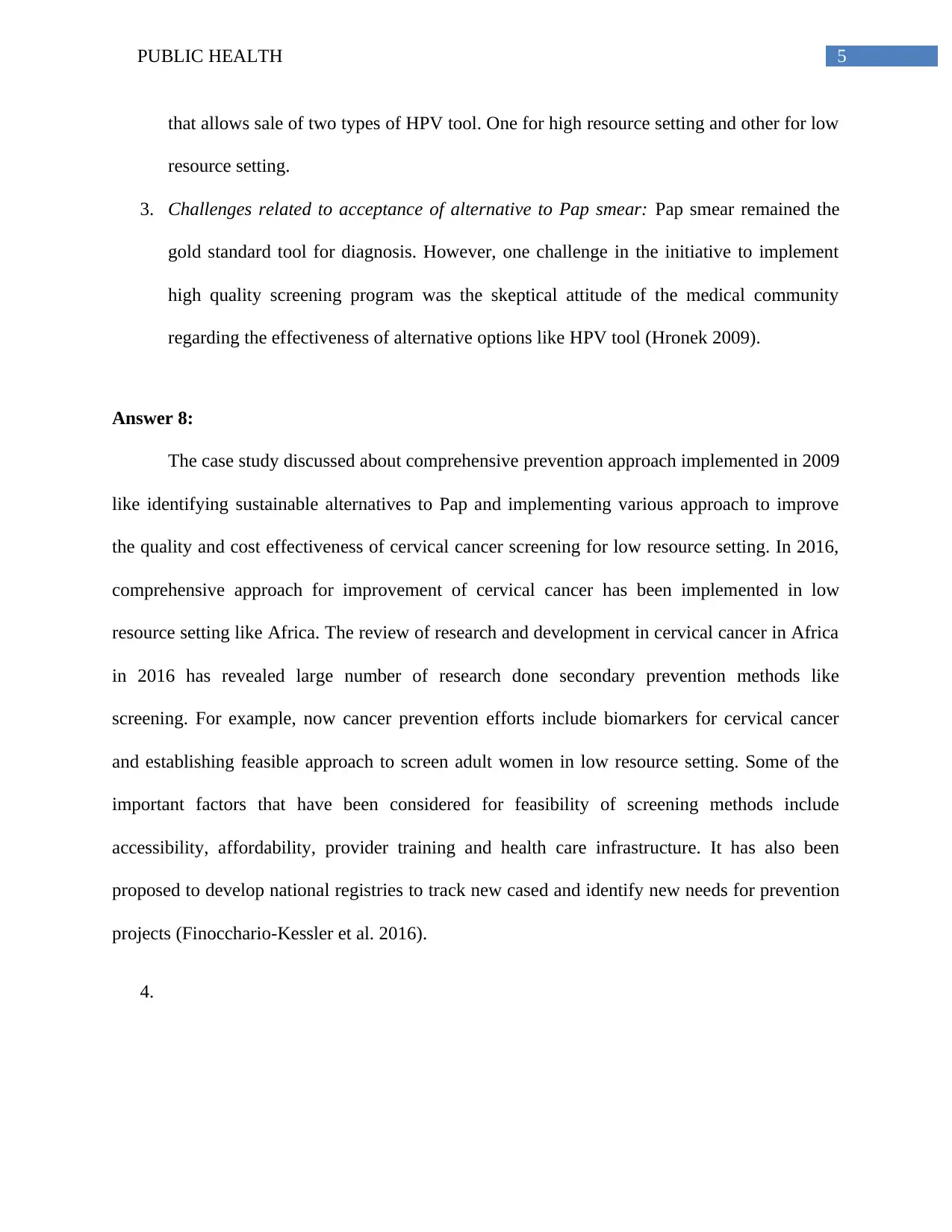
5PUBLIC HEALTH
that allows sale of two types of HPV tool. One for high resource setting and other for low
resource setting.
3. Challenges related to acceptance of alternative to Pap smear: Pap smear remained the
gold standard tool for diagnosis. However, one challenge in the initiative to implement
high quality screening program was the skeptical attitude of the medical community
regarding the effectiveness of alternative options like HPV tool (Hronek 2009).
Answer 8:
The case study discussed about comprehensive prevention approach implemented in 2009
like identifying sustainable alternatives to Pap and implementing various approach to improve
the quality and cost effectiveness of cervical cancer screening for low resource setting. In 2016,
comprehensive approach for improvement of cervical cancer has been implemented in low
resource setting like Africa. The review of research and development in cervical cancer in Africa
in 2016 has revealed large number of research done secondary prevention methods like
screening. For example, now cancer prevention efforts include biomarkers for cervical cancer
and establishing feasible approach to screen adult women in low resource setting. Some of the
important factors that have been considered for feasibility of screening methods include
accessibility, affordability, provider training and health care infrastructure. It has also been
proposed to develop national registries to track new cased and identify new needs for prevention
projects (Finocchario-Kessler et al. 2016).
4.
that allows sale of two types of HPV tool. One for high resource setting and other for low
resource setting.
3. Challenges related to acceptance of alternative to Pap smear: Pap smear remained the
gold standard tool for diagnosis. However, one challenge in the initiative to implement
high quality screening program was the skeptical attitude of the medical community
regarding the effectiveness of alternative options like HPV tool (Hronek 2009).
Answer 8:
The case study discussed about comprehensive prevention approach implemented in 2009
like identifying sustainable alternatives to Pap and implementing various approach to improve
the quality and cost effectiveness of cervical cancer screening for low resource setting. In 2016,
comprehensive approach for improvement of cervical cancer has been implemented in low
resource setting like Africa. The review of research and development in cervical cancer in Africa
in 2016 has revealed large number of research done secondary prevention methods like
screening. For example, now cancer prevention efforts include biomarkers for cervical cancer
and establishing feasible approach to screen adult women in low resource setting. Some of the
important factors that have been considered for feasibility of screening methods include
accessibility, affordability, provider training and health care infrastructure. It has also been
proposed to develop national registries to track new cased and identify new needs for prevention
projects (Finocchario-Kessler et al. 2016).
4.
⊘ This is a preview!⊘
Do you want full access?
Subscribe today to unlock all pages.

Trusted by 1+ million students worldwide
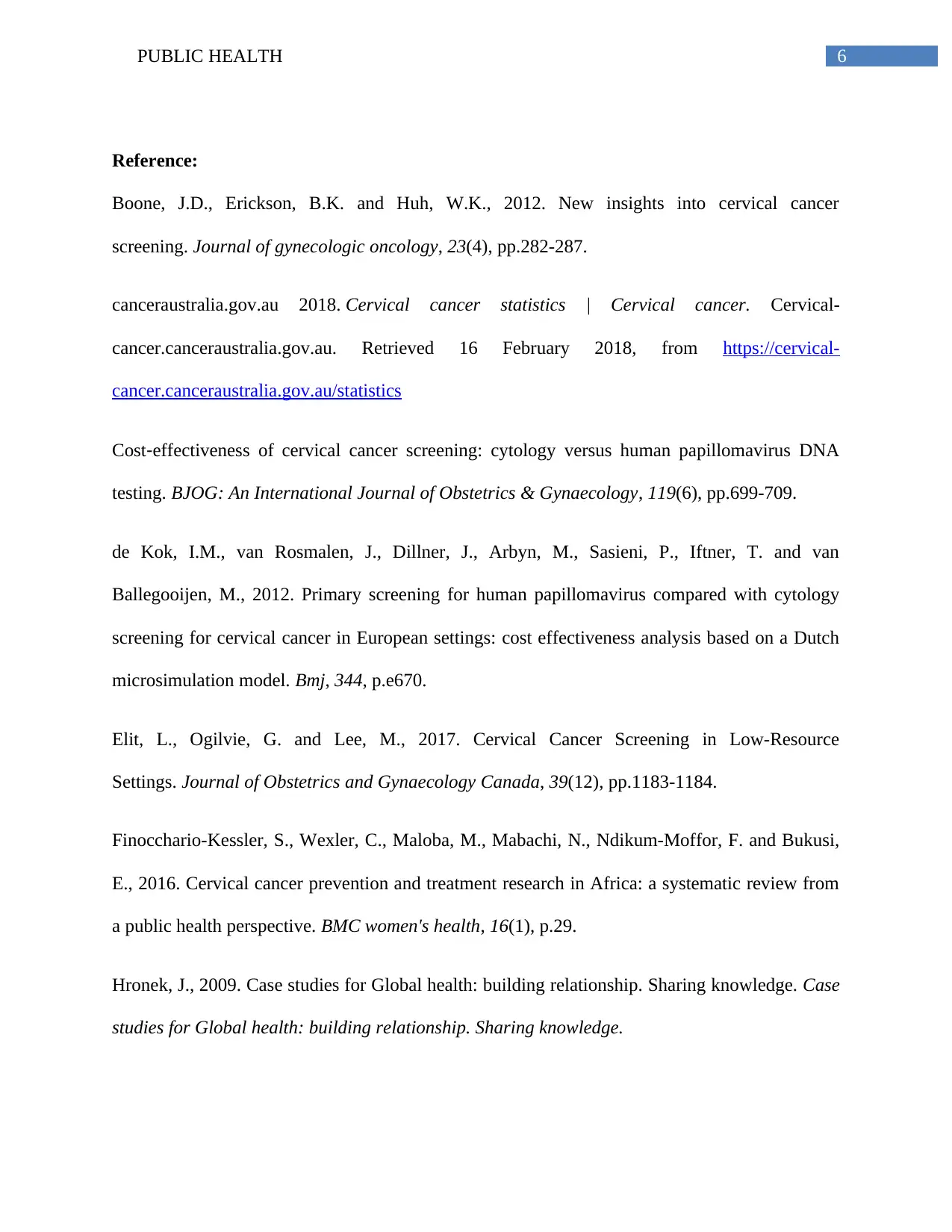
6PUBLIC HEALTH
Reference:
Boone, J.D., Erickson, B.K. and Huh, W.K., 2012. New insights into cervical cancer
screening. Journal of gynecologic oncology, 23(4), pp.282-287.
canceraustralia.gov.au 2018. Cervical cancer statistics | Cervical cancer. Cervical-
cancer.canceraustralia.gov.au. Retrieved 16 February 2018, from https://cervical-
cancer.canceraustralia.gov.au/statistics
Cost‐effectiveness of cervical cancer screening: cytology versus human papillomavirus DNA
testing. BJOG: An International Journal of Obstetrics & Gynaecology, 119(6), pp.699-709.
de Kok, I.M., van Rosmalen, J., Dillner, J., Arbyn, M., Sasieni, P., Iftner, T. and van
Ballegooijen, M., 2012. Primary screening for human papillomavirus compared with cytology
screening for cervical cancer in European settings: cost effectiveness analysis based on a Dutch
microsimulation model. Bmj, 344, p.e670.
Elit, L., Ogilvie, G. and Lee, M., 2017. Cervical Cancer Screening in Low-Resource
Settings. Journal of Obstetrics and Gynaecology Canada, 39(12), pp.1183-1184.
Finocchario-Kessler, S., Wexler, C., Maloba, M., Mabachi, N., Ndikum-Moffor, F. and Bukusi,
E., 2016. Cervical cancer prevention and treatment research in Africa: a systematic review from
a public health perspective. BMC women's health, 16(1), p.29.
Hronek, J., 2009. Case studies for Global health: building relationship. Sharing knowledge. Case
studies for Global health: building relationship. Sharing knowledge.
Reference:
Boone, J.D., Erickson, B.K. and Huh, W.K., 2012. New insights into cervical cancer
screening. Journal of gynecologic oncology, 23(4), pp.282-287.
canceraustralia.gov.au 2018. Cervical cancer statistics | Cervical cancer. Cervical-
cancer.canceraustralia.gov.au. Retrieved 16 February 2018, from https://cervical-
cancer.canceraustralia.gov.au/statistics
Cost‐effectiveness of cervical cancer screening: cytology versus human papillomavirus DNA
testing. BJOG: An International Journal of Obstetrics & Gynaecology, 119(6), pp.699-709.
de Kok, I.M., van Rosmalen, J., Dillner, J., Arbyn, M., Sasieni, P., Iftner, T. and van
Ballegooijen, M., 2012. Primary screening for human papillomavirus compared with cytology
screening for cervical cancer in European settings: cost effectiveness analysis based on a Dutch
microsimulation model. Bmj, 344, p.e670.
Elit, L., Ogilvie, G. and Lee, M., 2017. Cervical Cancer Screening in Low-Resource
Settings. Journal of Obstetrics and Gynaecology Canada, 39(12), pp.1183-1184.
Finocchario-Kessler, S., Wexler, C., Maloba, M., Mabachi, N., Ndikum-Moffor, F. and Bukusi,
E., 2016. Cervical cancer prevention and treatment research in Africa: a systematic review from
a public health perspective. BMC women's health, 16(1), p.29.
Hronek, J., 2009. Case studies for Global health: building relationship. Sharing knowledge. Case
studies for Global health: building relationship. Sharing knowledge.
Paraphrase This Document
Need a fresh take? Get an instant paraphrase of this document with our AI Paraphraser
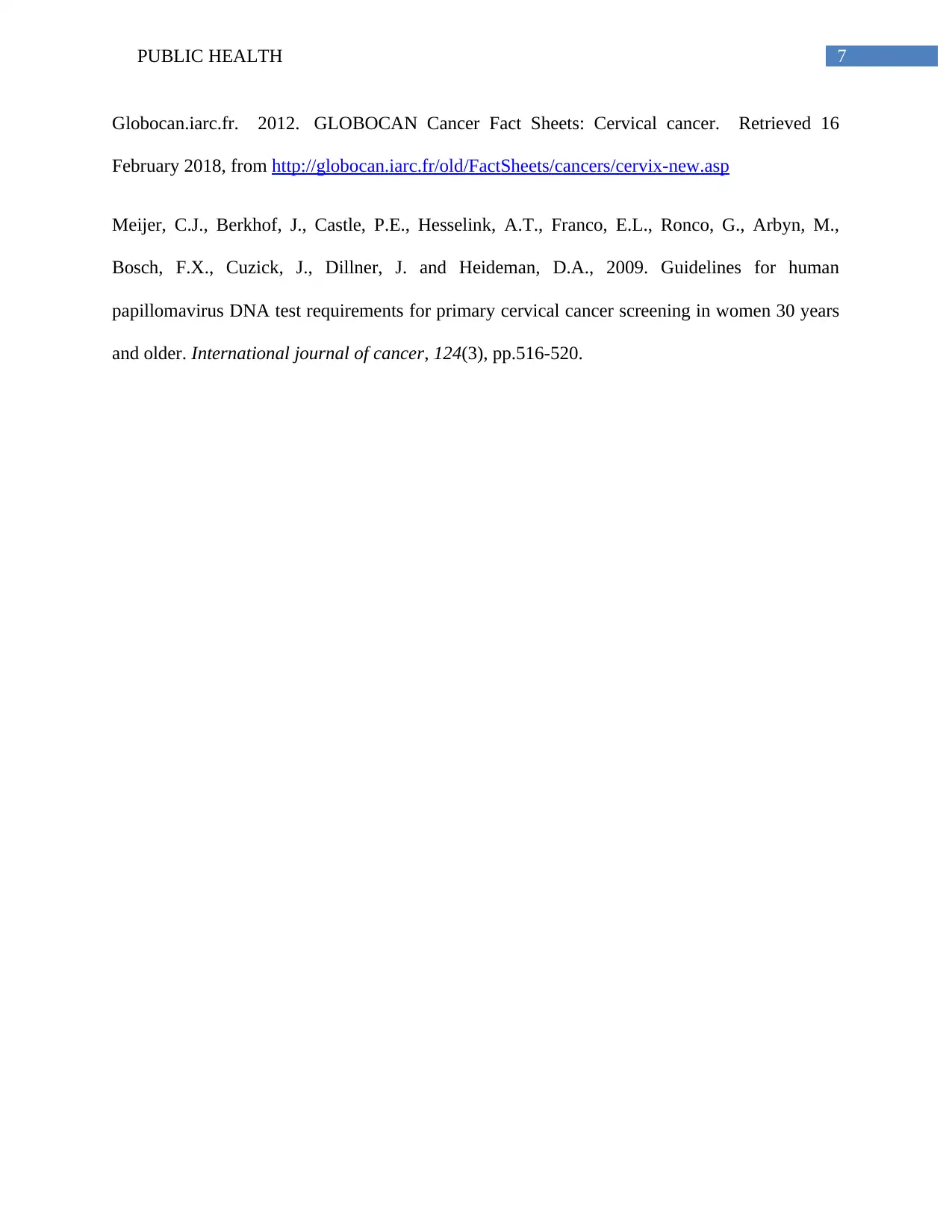
7PUBLIC HEALTH
Globocan.iarc.fr. 2012. GLOBOCAN Cancer Fact Sheets: Cervical cancer. Retrieved 16
February 2018, from http://globocan.iarc.fr/old/FactSheets/cancers/cervix-new.asp
Meijer, C.J., Berkhof, J., Castle, P.E., Hesselink, A.T., Franco, E.L., Ronco, G., Arbyn, M.,
Bosch, F.X., Cuzick, J., Dillner, J. and Heideman, D.A., 2009. Guidelines for human
papillomavirus DNA test requirements for primary cervical cancer screening in women 30 years
and older. International journal of cancer, 124(3), pp.516-520.
Globocan.iarc.fr. 2012. GLOBOCAN Cancer Fact Sheets: Cervical cancer. Retrieved 16
February 2018, from http://globocan.iarc.fr/old/FactSheets/cancers/cervix-new.asp
Meijer, C.J., Berkhof, J., Castle, P.E., Hesselink, A.T., Franco, E.L., Ronco, G., Arbyn, M.,
Bosch, F.X., Cuzick, J., Dillner, J. and Heideman, D.A., 2009. Guidelines for human
papillomavirus DNA test requirements for primary cervical cancer screening in women 30 years
and older. International journal of cancer, 124(3), pp.516-520.
1 out of 8
Related Documents
Your All-in-One AI-Powered Toolkit for Academic Success.
+13062052269
info@desklib.com
Available 24*7 on WhatsApp / Email
![[object Object]](/_next/static/media/star-bottom.7253800d.svg)
Unlock your academic potential
Copyright © 2020–2025 A2Z Services. All Rights Reserved. Developed and managed by ZUCOL.



